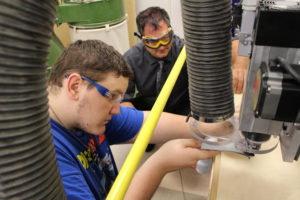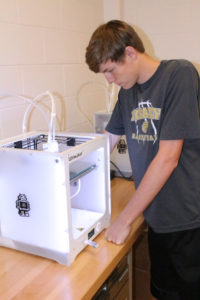By Lee Ann Wainwright
If a John Marshall High School student needs a new phone case, a simple Wal-Mart trip or Amazon order will likely do the trick, but when classes resumed this fall, students had another choice—make one.
Working to enhance STEM opportunities, John Marshall High School opened West Virginia’s first FabLab this fall. This hands-on digital fabrication laboratory provides students with a collaborative workspace where they can create innovative products using tools and materials such as 3-D printers, laser cutters, design software and ShopBot CNC routers.

“We are super excited about it. We’ll be the first FabLab registered in West Virginia,” says John Marshall High School Assistant Principle Katie Dantrassy. “Chevron helped us learn about the FabLab network and connected us with other schools we could shadow and look at in the greater area. So it’s not necessarily Chevron funding us but partnering with us as a business that is going to help enrich our curriculum, and that’s amazing in and of itself.”
The high school’s new FabLab is part of the Appalachia Partnership Initiative’s (API) efforts to generate more STEM education opportunities for K-12 students in the region. Recognizing a need to boost STEM education, API launched in 2014 as a partnership of Chevron, the Allegheny Conference on Community Development, the Claude Worthington Benedum Foundation and The Grable Foundation to implement, kick-start and fund FabLabs, Maker Spaces and innovative approaches to education throughout the tri-state region.
“The STEM field is so promising for students coming out of John Marshall and Cameron-area schools, and we want to prepare students for that,” says Woody Yoder, director of curriculum and instruction in Marshall County.
Recent data from the RAND Corporation—a national nonprofit research organization and API research partner—suggests boosting STEM education programs could lead to more high-paying career opportunities in the growing local energy and manufacturing fields.
While John Marshall students will have new hands-on learning opportunities through the FabLab this year, Chevron and API have long partnered with Marshall County. Over the last five years, Marshall County schools have received more than $290,000 from Chevron to fund another STEM-focused program called Project Lead the Way.

Project Lead the Way is a national, nonprofit organization that provides transformative learning experiences for K-12 students. Since 2013, Chevron has provided more than $2.2 million in grants to either start or expand this program in school districts throughout West Virginia, Ohio and Pennsylvania. In Marshall County, Chevron’s funding for this program has allowed the county’s elementary, middle and high schools to offer several engineering and computer science elective courses.
“There’s a lot of excitement with students,” says Yoder of the hands-on STEM courses. “They love the curriculum, they love the opportunity to work in groups, and they love the opportunity to present.”
The capability to solve problems independently is a product teachers at John Marshall High School hope to see develop in students while working in the FabLab or taking Project Lead The Way courses, such as the engineering design and development class. Seniors are eligible to enroll in this capstone course that focuses on finding solutions to practical real-world problems.
“With all of the equipment and capabilities we are going to have this year and all of the technology, if you can imagine it, you can probably build it and construct it here,” says Gavin Hurtle, John Marshall High School math teacher and FabLab coordinator. “The thing about this course is it’s a truly student-driven course. They come up with the problem. I’m not assigning them anything. I’m a resource at that point.”
At the end of the year, the students will present their solutions to a panel of local industry professionals, according to both Dantrassy and Yoder, who emphasized that the company’s involvement in the school goes far beyond just providing funding.
“One thing I find that’s unique about Chevron is they’re so willing to come in and be a partner with our design challenge; listen to different ideas; and talk about curriculum, how we can improve our STEM program and how we can participate actively in our school,” says Dantrassy.
Yoder knows the implementation of STEM courses in West Virginia schools will result in students one day contributing that knowledge to benefit the region, a goal shared with Chevron and the API partners.
“I envision myself someday being an old guy driving along the Ohio River, and I look over at a completed cracker plant and say, ‘You know what? There is a John Marshall or Cameron grad that took an idea and established some business and is now employing hundreds of people here in Marshall County,’” says Yoder. “And the root for doing that was an engineering course, Project Lead the Way, Maker Space or FabLab student that came out of John Marshall or Cameron High School. So that’s what this is about.”
 About the Author
About the Author
Lee Ann Wainwright, a native of southeastern Ohio and graduate of Marietta College, is the STEM Education Investment Team Lead and Public Affairs Representative for Chevron Appalachia. Based near Pittsburgh, PA, Wainwright works through the Appalachia Partnership Initiative to help organizations and communities in the region develop, promote and invest in new STEM education programs and innovative learning practices.








